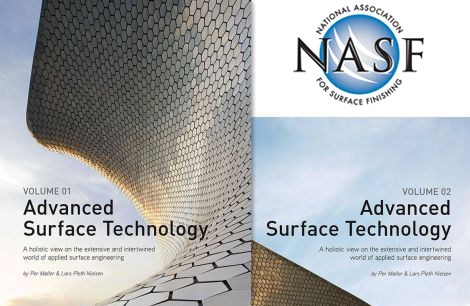NASF Launches Comprehensive Surface Finishing Guide
"Advanced Surface Technology" is one of the most comprehensive reference to date for a wide range of coating and finishing applications, as the publication is both a practical guide for any professional or operation in the coatings value chain.

The National Association for Surface Finishing has announced the release of the much-anticipated resource for the surface coatings industry – Advanced Surface Technology.
Advanced Surface Technology is the most comprehensive reference to date for a wide range of coating and finishing applications. The publication is both a practical guide for any professional or operation in the coatings value chain, as well as a core text for the teaching of engineers and scientists at all levels in the field of surface technology.
The two-volume hardcover set, authored by Drs. Per Moller and Lars Pleth Nielsen, contains the most current information in an understandable format and is filled with numerous easy-to-understand illustrations, charts and descriptive graphics. It should serve as an inclusive, easy-to-use tool for finishers, suppliers, and the OEM community.
The book will also serve as the basis for future updates. The authors aim to update the text with new information and link to additional online resources.
“We’re quite pleased to be a partner with the authors on this project,” said NASF President, Rick Delawder. “Industrial surface finishers around the world now have a great new resource to both keep current and gain new knowledge to help benefit their companies and their customers.”
The two-volume hardcover set is now available for purchase online through the NASF website, NASF.org for $130.00 plus handling for domestic and international shipping.
Related Content
-
NASF/AESF Foundation Research Project #122: Electrochemical Approaches to Treatment of PFAS in Plating Wastewater - 12th Quarterly Report
This NASF-AESF Foundation research project report covers the 12th quarter of project work (October – December 2023) at the University of Georgia. In our previous report, we described our work on performance and effect of surface fluorinated Ti4O7 anodes on PFAS degradation in reactive electrochemical membrane (REM) mode. This quarter, our experiments involved utilizing porous Ti4O7 plates serving both as anodes and membranes. Tests compared pristine and F-18.6 Ti4O7 anodes at current densities of 10 mA/cm2 and 40 mA/cm2. This 12th quarterly report discusses the mechanisms of the effects on EO performance by anode surface fluorination.
-
Top 5 Areas to Consider Automation of Plating Operations
Automation for finishing operations can lead to improvements in process time, repeatability and consistency of quality. Yet, processes that make sense to explore for these operational efficiencies may not always be readily apparent.
-
Hubbard-Hall Acquires BioConversion Technology
The acquisition adds experience and biologics to the AquaPure product line.














.jpg;maxWidth=300;quality=90)
